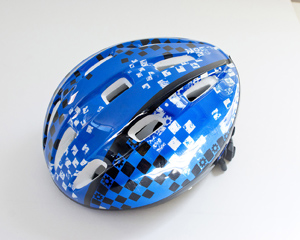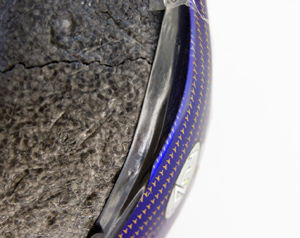
Features of a safe bicycle helmet

Outer shell
 Description:
Description:
The hard plastic layer is glued or taped to the inner shell. Some helmets have ventilation holes (vents) and/or a plastic visor attached that is designed to detach in a collision. Helmets come in a variety of colours and designs.
Function:
- Protects the inner shell
- Helps the helmet slide easily across the road surface in a fall or collision. Less friction means that the rider’s head or neck is less likely to experience a sudden jerk and cause injury.

What to look for:
The outer shell should be smooth with no damage.
Avoid helmets with
- Cracks or the inner shell peeling away (see example)
- Stickers or attachments that were not part of the original design.
*Be wary of helmets with items such diamante stickers or soft foam spikes attached and/or with certification not relevant to bike riding. They may be visually appealing but they are not safe to use. You may also find items such as a high vis cover, helmet hat or mirror attachments. These affect the function of the outer shell.
Inner shell
 Description:
Description:
The Expanded Polystyrene (EPS) foam layer that is often black or white in colour. Most approved manufacturers attach the Australian Standard sticker with the code AS/NZS 2063 on the inner shell.. It is not recommended to remove the padding.
Function:
On impact protects the head from serious injury by absorbing the kinetic energy softening the blow to the head.
A helmet should be replaced if it has been involved in a crash. There may not be any noticeable signs of damage or indentation but the foam will not able to effectively compress and absorb another impact.

What to look for:
- The Australian Standards sticker. If it doesn't have the code AS/NZS 2063 then it is not safe or legal to use in Australia.
- No cracks or chunks of foam missing.
Straps
 Description:
Description:
Made of strong material such as nylon or polypropylene and attached to the side of the helmet.
Function:
Hold the helmet to the riders head. In the correct position the adjuster should sit just underneath the ear.
What to look for:
- No fraying or damage to the straps.
- Straps can be adjusted for a correct fit.
Buckle
 Description:
Description:
The black plastic clip found at the bottom of the strap.
Function:
To connect the straps and hold the helmet to the head.
What to look for:
- Check that the buckle snaps in properly and stays secure when tugged.
Stabiliser
 Description:
Description:
The knob or adjuster found at the back end of the helmet. It can be adjusted by twisting or pushing together to tighten.
Function:
Adjusts the diameter of the helmet for a snug fit on the head.
What to look for:
- Once adjusted in should stay in place and not loosen
If a helmet is still loose or tight after adjusting the stabiliser this means the helmet is not the correct size for the rider, and should be replaced.


